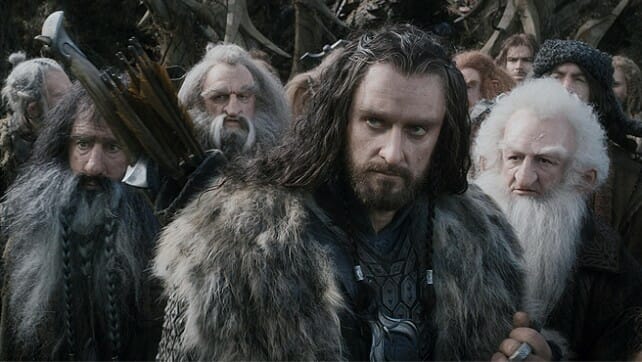The Hobbit: The Desolation of Smaug

From the moment it was announced that Peter Jackson’s film version of J.R.R. Tolkien’s The Hobbit would be made into a trilogy, there was a good degree of skepticism over how successfully such a small tale could be expanded to take up a solid eight hours (over the course of three years). Even though the “cinematic mitosis” approach to filmmaking, begun with the 2003 release of Matrix Reloaded and Matrix Revolutions, has become pretty much standard operating procedure for any studio wishing to juice an extra movie’s worth of profit from the source material, Jackson and company were going for a three for one. Whether one considered this approach foolish, audacious or avaricious, it was undeniably ambitious. The Hobbit: An Unexpected Journey suggested the template Jackson would adopt: Open with a flashback (or two), add whole cloth plenty of “Gandalf’s Adventures in Dol Goldur,” and then sttrreeettcch out the action sequences. These sequences may have in turn stretched viewer credulity, but it also resulted in a film that’s earned more than $1 billion in world box office. (Forget “Might makes right.” In Hollywood, “Profitable equals good.”)
Despite its success, the immense charm of Tolkien’s original tale had already mostly sloughed off by the end of the first film. (In hindsight, that process was well underway not long after the party left Bag End.) In The Hobbit: The Desolation of Smaug, whatever flecks remained are scoured off by artificially sustained tension, a plot that’s forgotten who the main character is, and an inter-racial romance that’s obviously an investment in making the Battle of the Five Armies more dramatic. (Oh, and don’t worry, your credulity won’t escape unstrained, either, thanks to a major change—by far the most profound in either of the two films thus far—to one of the most important encounters in the book.) In place of the charm, Jackson, Walsh and Boyens have brought non-stop, mostly elf-on-orc action—if you’ve ever wished there was a YouTube tutorial made by elves and entitled: “101 Ways to Lithely Kill Your Foes,” you’re in luck.
Desolation picks up where The Hobbit: An Unexpected Journey left off: Our band of heroes, having been rescued from the dreaded Flaming Domino Trees via Giant Eagle Taxis, now continues its journey toward lost Erebor. Still pursued by Azok the Defiler and his unending supply of homicidally inclined orcs, and probably at least occasionally wondering why the eagles couldn’t just have flown them on over to the Lonely Mountain, Team Dwarf +1 must make its way past shapechangers and the murkiest of woods, a forest teeming with life both hostile (giant spiders!) and dickish (wood elves!). From there, Laketown, Erebor and the big S himself itself are just a (very long) flume zoom ride, a Stephen Colbert cameo and a hidden keyhole away!
For those able to let go of any hope that Desolation will retain any of the more subtle aspects of Tolkien’s little tale—and for those with no prior allegiance or expectation to begin with—there’s plenty to enjoy in this latest journey to Middle Earth. Much like Bilbo’s encounter with Gollum in the first film, the party’s “meet-ick” with the giant spiders is among those moments most faithful to the book. The entrance of Legolas (Orlando Bloom) and Tauriel (Evangeline Lilly) to the story is followed by a stream of mini-set action pieces that, for the most part, each succeed in impressing viewers with their lethal choreography. (Thankfully, Desolation shows a tad more restraint in the Stooge-ification of the dwarves.)
-

-

-

-

-

-

-

-

-

-

-

-

-

-

-

-

-

-

-

-

-

-

-

-

-

-

-

-

-

-

-

-

-

-

-

-

-

-

-

-








































